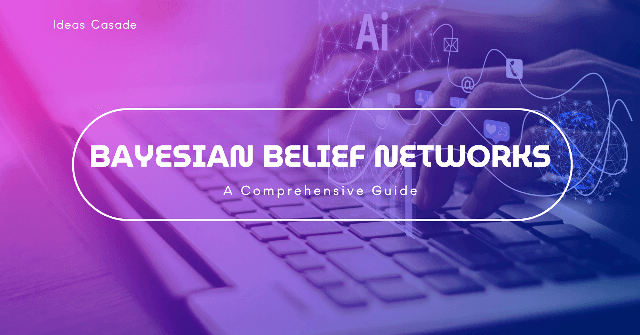Understanding complex systems is hard. But Bayesian Belief Networks (BBNs) make it easier. If you want to predict outcomes, model uncertainty and support better decisions then you need to learn about BBNs. This Complete Guide to Bayesian Belief Networks (BBNs) and Their Applications will help you, especially if you are from the USA, where decision support systems are becoming vital in industries like healthcare, finance and technology.
By the end of this article, you’ll understand how Bayesian networks represent uncertainty, the importance of conditional independence and how they are shaping the future of machine learning models and risk assessment tools. We’ll keep it simple, practical and full of real examples.
Introduction to Bayesian Networks
At its core, a Bayesian Belief Network (BBN) is a probabilistic graphical model. It shows how different factors are related. A BBN uses a directed acyclic graph (DAG) to connect variables. The entire graph represents a variable as each node represents one variable and arrows between nodes show conditional dependencies between variables.
BBNs are special because they let us model uncertainty in a clear way. You can easily simplify probability calculations by using conditional probability instead of calculating the full set of possibilities. If you’ve ever wondered about using Bayesian networks in AI or why they are becoming so popular in healthcare and finance it’s because they make sense of complex problems quickly and accurately.
Core Concepts of Bayesian Belief Networks
The heart of a belief network lies in explaining probabilistic relationships between variables. Each node’s behavior depends only on its parent nodes thanks to the importance of conditional independence. This dramatically cuts down the work needed to calculate outcomes.
One key concept is the joint probability distribution. Instead of calculating every possible event separately BBNs combine them smartly. Another big idea is Bayes’ theorem which updates beliefs when new information comes in. It’s why doctors can update a diagnosis as new symptoms appear or why banks can update fraud risk when a strange transaction happens.
Working with Bayesian Networks
Working with a BBN starts with setting up your directed acyclic graph (DAG). You need to define the nodes (variables) and the links (dependencies). After that you calculate the joint distribution using Bayesian methods.
When new evidence comes in you perform inference with Bayesian networks. Inference means figuring out the most likely causes or outcomes based on what you know. Techniques like the variable elimination algorithm for approximate inference techniques help do this faster. For beginners, it’s like solving a puzzle by filling in missing pieces based on what you already see.
Learning and Training Bayesian Networks
Bayesian network learning algorithms focus on two main things structure learning in Bayesian networks and parameter learning. Structure learning means figuring out how nodes should be connected. It’s a bit like solving a mystery looking for hidden patterns.
Meanwhile, parameter learning means figuring out the strength of these relationships. Many times people use maximum likelihood estimation (MLE) to get the best parameters. Some networks even use Monte Carlo simulations to handle messy real-world data. If you are learning the structure of Bayesian networks expect to work with lots of data and careful modeling.
Bayesian Networks and Machine Learning Techniques
Bayesian Belief Networks fit perfectly with modern machine learning models. They can be used for linear regression, classification or even clustering. For instance regularization techniques help avoid overfitting which is when a model is too closely tailored to training data and fails on new data.
In practice, combining BBNs with methods like K-Nearest Neighbors (KNN) or Support Vector Machines (SVM) gives you powerful models. Whether you are building recommendation engines or fraud detection systems understanding Bayesian models for beginners is the first step. Plus Bayesian methods shine in uncertainty modeling where other machine learning models might struggle.
Real-World Bayesian Networks Applications
Real-world applications of Bayesian networks are everywhere. In healthcare they help doctors predict diseases early. In cybersecurity they predict breaches before they happen. And in manufacturing they forecast machine failures before costly breakdowns occur.
| Industry | Use Case |
| Healthcare | Disease diagnosis, treatment prediction |
| Finance | Fraud detection, credit scoring |
| Manufacturing | Predictive maintenance, quality control |
| Cybersecurity | Intrusion detection, threat assessment |
| Business Management | Risk assessment tools, decision-making |
Practical uses of belief networks include detecting faulty products before shipment, planning supply chains and even recommending movies to users. These examples of Bayesian belief networks show how powerful and flexible they are.
Common Challenges When Working With Bayesian Networks
Even though Bayesian Belief Networks are powerful they have challenges. One big problem is dealing with missing or bad data. If the input is wrong the output predictions are also wrong.
Another challenge is scalability. Inference algorithms become slow when networks grow large. People often turn to approximate inference techniques or Monte Carlo simulations to make things faster. Also, setting up the correct structure requires expertise. Learning the structure of Bayesian networks very tricky without enough data.
Interview Insights and Common Questions
If you are preparing for a data science interview expect questions like: “How do Bayesian networks model probabilistic relationships between variables?” You’ll need to explain conditional dependencies between variables and the importance of conditional independence clearly.
Another favorite is “Can you explain how performing inference with Bayesian networks simplifies probability calculations?” Real life examples of applying Bayesian Networks for instance in predicting machine failures or for diagnosis in diseases become favorite subjects of discussion during interviews.
FAQs
What is a Bayesian Belief Network (BBN)?
A Bayesian Belief Network is a graphical model which is probabilistic in nature and represents the relations between variables with the help of a directed acyclic graph (DAG) technique.
How do Uncertainty Bayesian Networks handle?
They manage uncertainty by using conditional probability to update beliefs based on new information.
What are applied examples of Bayesian networks in the real world?
Applied examples of Bayesian networks in real life diagnoses, fraud detection, predictive maintenance.
What is Learning structure in Bayesian networks?
Learning structure in Bayesian networks involves finding the best connections between variables using data.
What is inference in Bayesian Networks?
Performing inference with Bayesian networks means predicting unknown values by using known evidence and inference algorithms.
Final Thoughts
In a world full of complex data Bayesian Belief Networks provide a clear way to handle uncertainty. They are changing industries by offering powerful risk assessment tools, smarter decision support systems and faster machine learning models.
This Complete Guide to Bayesian Belief Networks (BBNs) and Their Applications showed you how BBNs work where they are used and why they matter. Whether you’re a beginner or a professional, learning BBNs can boost your skills and open new doors especially in the booming US tech and healthcare industries.



